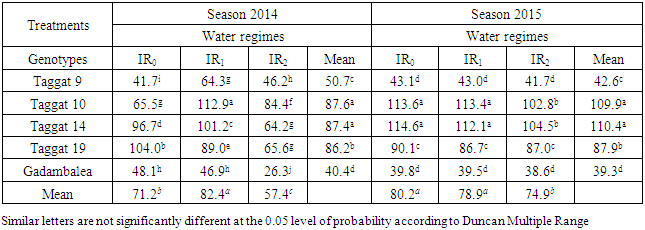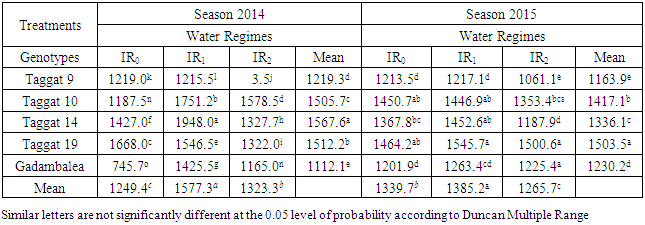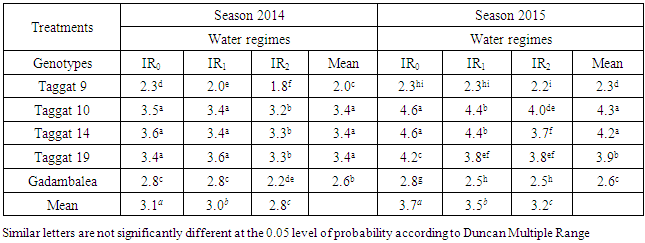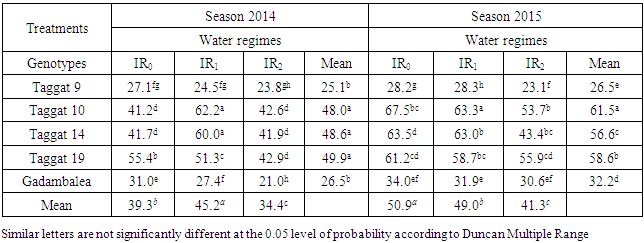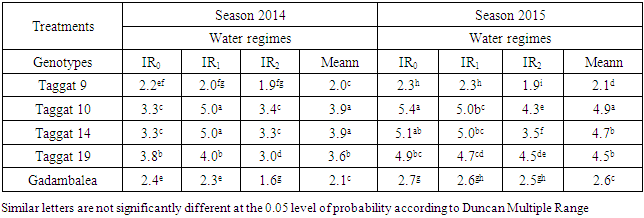-
Paper Information
- Paper Submission
-
Journal Information
- About This Journal
- Editorial Board
- Current Issue
- Archive
- Author Guidelines
- Contact Us
International Journal of Agriculture and Forestry
p-ISSN: 2165-882X e-ISSN: 2165-8846
2017; 7(1): 1-6
doi:10.5923/j.ijaf.20170701.01

Effect of Water Stress on Yield and Water Use Efficiency of Sorghum (Sorghum bicolor L. Moench) in Semi-Arid Environment
Abderhim A. Jabereldar1, Ahmed M. El Naim1, Awad A. Abdalla1, Yasin M. Dagash2
1Department of Crop Sciences, Faculty of Natural Resources and Environmental Studies, University of Kordofan, Elobeid, Sudan
2Department of Agronomy, Faculty of Agriculture, Sudan University of Science and Technology, Khartoum North, Sudan
Correspondence to: Ahmed M. El Naim, Department of Crop Sciences, Faculty of Natural Resources and Environmental Studies, University of Kordofan, Elobeid, Sudan.
| Email: |  |
Copyright © 2017 Scientific & Academic Publishing. All Rights Reserved.
This work is licensed under the Creative Commons Attribution International License (CC BY).
http://creativecommons.org/licenses/by/4.0/

Drought stress (abiotic stress) is a serious obstacles for crops, especially in the arid and semi-arid tracts of the world. Increases in crop yields are through the genetic enrichment by introducing multiple quantitative traits to enhanced stress tolerance during the different growth stages. This paper presents the findings of the effects of some selected deficit irrigation scheduling practices on seed yield and water use efficiency of five sorghum genotypes (Taggat 9, Taggat 10, Taggat 14, Taggat 19 and Gadambalea cultivar) in the experimental farm of the Faculty of Natural Resources, University of Kordofan, Sudan for two successive seasons (2014 and 2015). The sorghum genotypes were subjected to water stress induced by holding irrigation for three weeks. Three water regimes were applied: control (irrigated every seven days), water stress imposed at three leaf stage and at eight leaf stage. The treatments were arranged in a split-plot design with four replications; with water regime treatments assigned to the main plots and sorghum genotypes to the sub-plots. The parameters studied were: panicle length (cm), panicle weight (g), number of grains per panicle, 100- grain weight (g), seed yield (g/plant), final seed yield (ton ha-1) and water use efficiency. The results showed that water stress at eight-leaf stage reduced panicle length, panicle weight, number of grains per panicle, 100- grain weight, seed yield and water use efficiency. The Taggat 10 genotype scored the high values of yield and water use efficiency measured in this study and it might be suitable for production under water stress environment.
Keywords: Sorghum, Abiotic stress, Cultivars, Yield components
Cite this paper: Abderhim A. Jabereldar, Ahmed M. El Naim, Awad A. Abdalla, Yasin M. Dagash, Effect of Water Stress on Yield and Water Use Efficiency of Sorghum (Sorghum bicolor L. Moench) in Semi-Arid Environment, International Journal of Agriculture and Forestry, Vol. 7 No. 1, 2017, pp. 1-6. doi: 10.5923/j.ijaf.20170701.01.
Article Outline
1. Introduction
- Sorghum (Sorghum bicolor L. Moench) it is the fifth most important cereal crop in the world and it is the dietary staple of more than 500 million people in more than 30 countries, and it ranking the fourth food grains of the world [1, 2]. Grain sorghum has so many local names among these: Durra, Feterita, Daza, Sorgo, Gonia corn, Egyptian millet, Jowar, Kaffir corn, Milo, Shallo and Sudan grass [2]. Most of people in Africa and Asia depend on sorghum as the staple food. In addition, the fodder and stover is feed to millions of animals providing milk and meat for people, over 55% of grain produced globally is used for human consumption and about 33% of grain used in feeding livestock. Globally sorghum is cultivated over an area of about 42.7 million ha with a production of about 58.7 million tonnes in many parts of the world [3]. Sorghum is capable to grow and produce yield at low rainfall areas. The crop is cultivated in areas considered too dry and hot for other cereals, because of its tolerance to drought and heat stress [4]. Grain sorghum, a well-adapted crop for central Sudan, is grown extensively under irrigated and dry land conditions. Abdalla and Gamar [5] stated that the total area under sorghum production in the Sudan is estimated to be about 6.0 million ha, which is 73% of the total cropped area. Only 10% of this area is irrigated and 90% under rain-fed conditions. Water deficit (commonly known as drought) can be defined as the absence of adequate moisture necessary for a plant to grow normally and complete its life cycle [6]. Drought stress is one of the most important environmental factors in reduction of growth, development and production of plants. It can be said that it is one of the most devastating environmental stresses [6, 7]. Water stress effects on grain yield, plant growth and development were thoroughly studied, but little information is available about its effects on physiological qualities of the seeds [8].Zinnari varieties are known to out yield local varieties on sandy soils of Kordofan (Sudan), under low rain fall conditions. The diversity of lines expresses a wide range of adaptability to different conditions, including different genotypes from early to late maturing, dwarf to tall, loose to compacted heads, white and red seeded. Zinnari lines are white- seeded types that meets the consumption habits of Sudan peoples, thus selection of adapted high yielding lines is highly accepted by consumers. Plant breeders are interested in developing cultivars with improved yield and other desirable agronomic and phenological characters [9].Therefore, they need more investigations. The objectives of this study are: 1) to estimate the drought resistance of five sorghum genotypes (Zinnari); 2) to evaluate the potentiality of each genotype to resist to water stress and the sensitivity of water stress among the studied genotypes and 3) to determine the effects of water stress at different stages of growth on yield components and water use efficiency.
2. Materials and Methods
2.1. The Experiment
- A field experiment was carried out for two successive seasons (2014/015 – 2015/016) at the Crop Sciences Experimental Farm, Faculty of Natural Resources and Environmental Studies, University of Kordofan. The area lies between latitude 16° 30"N, and longitude 27° 32"E. The climate of the area is arid and semi-arid. The soil is sandy, annual rainfall ranges between 350-450 mm. Average maximum daily temperature ranges between 30-50°C throughout the year [22].The experimental material consisted of five sorhum genotypes coded Taggat 9, Taggat 10, Taggat 14, Taggat 19 and Gadambalea (improve cultivar) and three regimes namely, IR1 ( stressed at 3-leaf stage). IR2 (stressed at 8-leaf stage) and IR0, control treatment, which was never stressed and irrigated every seven days. Water stress was applied at a particular stage, by withholding irrigation for three weeks and then irrigated as in control (IR0). The trial was laid out in a split plot design replicated four times with plot size of 4 m2. Water regime treatments were assigned to main plots, and sorghum genotypes were assigned to the subplots. Sowing was on the 15th of July in both seasons, at a spacing of 0.50 m between rows and 0.50 m between plants within rows. Hand weeding was done at 15 and 30 DAS in the two seasons, to keep the crop weed free. No pest or diseases were observed in both seasons.
2.2. Character Studied
- - Panicle length (cm): Mean length of the panicle was measured on a sample of five panicles starting from the base to the tip of the head;- Panicle weight (g): random five heads of each plot weighed and divided by five;- Number of grains per panicle;- Grain weight (g): based on random sample of 100-seeds taken four times from the bulked seeds of each experimental unit;- Grain yield per plant (g); - Grain yield (kg/ha): panicles from each plot were harvested, sun dried, threshed, weighed and converted to t/ha;- Water use efficiency: the calculation of water use efficiency (WUE) as kg m–3 was based on the relation between consumptive use (CU), and seed yield for each water regime treatment in both seasons.
2.3. Statistical Analysis
- The collected data were subjected to the statistical analysis of variance according to Gomez and Gomez [11] for spilt–plot design, by using computer program (MSTATC). Means were tested and separated using Duncan Multiple Range Test (DMRT) at p =0.05.
3. Results and Discussion
3.1. Panicle Length
- Table 1 showed that full-watered plants scored the highest head length in both seasons. On the other hand, stresses plants (withholding irrigation at eight-leaf stage) recorded the lowest one (21.2 and 22.6 cm in first and in the second season, respectively). Hale and Orcutt [12] found that water stress reduces the rate of cell expansion and ultimately cell size and growth rate. Taggat 14 genotypes recorded the highest head length (29.1cm). In contrast, Gadambalea and Taggat 9 recorded the lowest head length (18.1 and 19.6 cm for first and second seasons, respectively). In contrast, Gadambalea and Taggat 9 recorded the lowest head length (18.1and 19.6 cm for season one and two, respectively). This may be due to genetic make-up of the genotype.
|
3.2. Panicle Weight
- Effects among each of the water regime and genotypes of head length were significant in both seasons (Table 2). The heaviest head weight 82.4 and 78.9 g recorded withholding irrigation at three-leaf stage for 21 days for first and second season respectively. In contrast, plants in stress (withholding irrigation at eight-leaf stage for 21 days) recorded the lowest head weight in both seasons. These results may be attributed to the reduction in days to physiological maturity or to the grain-filling period in (GS3) [10, 13]. Regarding genotypes, the heaviest ones in the two seasons were Taggat 10 and 14 recorded, While Gadambalea cultivar recorded the lowest head weight (between 40 and 51 g). Difference in panicle weight could be due differences in the panicle and seed size among genotypes.
|
3.3. Number of Grains Per Panicle
- Data presented in the Table (3) indicated that, the effect of water regime and genotypes had significant differences in number of grain per head. The stress imposed at 8- leaf stage decreased the number of grains per panicle greater than other water regime treatments. Seed number reduction might be to the plant stress at floral initiation stage, affect pollination and led to abortion of floret. The genotypes Taggat 14 in the first season and Taggat 19 in the second season recorded greater number of grains per panicle (1567.6 and 1503.5 grain respectively). On the other hand, Gadambalea cultivar and Taggat 9 scored fewer grains per head (1112.1 and 1219.3 grain in first and second season, respectively). Variation in number of seeds per panicle among genotypes could be due to their response to water stress. This result is in line with Boyer and Westgate [14]. They reported that grain yield and seed set reductions in small grains under drought stress are likely due to ovary abortion or pollen sterility.
|
3.4. 100- Grain Weight
- Analysis of variance for 100-grain weight showed that water stress and genotypes had significant effects in both seasons. Mean separation (Table 4) indicated that plants watering every seven days were significantly had a heavier 100-grain weight in both seasons (3.1 and 3.7 grams respectively). The stress at 8-leaf stage recorded the lesser 100-seed weight. Reduction in seed size was also found by earlier workers [15-19]. They stated that grain weight tended to increase in full watered plants compared to stress ones. Seed weight is a component of yield, which reflects relationship between source and sink of photosynthate during seed filling stage.
|
3.5. Grain Yield (g/plant)
- Significant effects among each of water regime, genotypes and their interactions were reported for grain yield per plant. Table 5 showed that plants in stress IR1 (with holding irrigation at 3-leaf stage) in first season and in full-watering in the second season produced the highest grain yield plant (45.2 and 50.9 g, respectively). Well-watered plants and stressed plants three leaf stage had more grain yield compared with stressed plants at eight-leaf stage. This is due to pollination susceptibility to water stress and seed weight [10]. With regard to genotypes, the highest estimates were recorded by Taggat 10 in both seasons. The interaction (Taggat 10 X IR1) produced the highest grain yield in both seasons (62.2 and 63.3 g, respectively). This was mainly due to the higher number of grains per head. Beil and Atkins [23] reported that seed number is the most important yield component associated with increased in yield of sorghum.
|
3.6. Grain Yield (t/ ha)
- Table 6 showed that the treatment IR2 (withholding irrigation at 8-leaf) gave the lowest seed yield in the both seasons (2.7 and 3.3 ton̸ ha, respectively). This was probably due to the negative effect of water shortage on the yield components such as seeds per panicle, 100-seed weight, panicle weight and seed yield per plant. In the genotypes treatment, the highest estimates were recorded by Taggat 10 in both season (3.9 and 4.9 ton̸ ha), while the lowest estimates were recorded by Gadambalea in the two seasons. The highest estimate for the interaction between these factors were recorded by Taggat 10 in each of stress IR1 in first season (5 ton̸ ha) and full-watering in the second season (5.4 ton̸ ha). The diverse genetic variability among sorghum genotypes might explain the variation in the performance of the studied genotypes in response to water stress.
|
3.7. Water Use Efficiency (WUE)
- Table 7 shows the average water use efficiency (WUE) as affected by water stress and sorghum genotypes. The results presented in Table 7 indicated that plants have significant change on seed yield and eventually on the crop water use efficiency (WUE). The treatment withholding irrigation at 3-leaf stage of the life cycle of sorghum had a better crop water use efficiency (WUE). This indicates that the efficiency of individual crop in this treatment is to convert water transpired (or used) to grain. The data also indicated that line Tagat 10 is more efficient in its water use than the other two lines. This increased water use efficiency due to increased seed yield of the crop [20, 21].
|
4. Conclusions
- The results obtained in this study showed that sorghum genotypes significantly differed in their response to drought and drought tolerance. The degree of drought tolerance depends on the interactions between the sorghum genotypes and the levels of water stress. The results suggested that genotype Tagat 10 was the most drought tolerant followed by genotype Tagat 14, while genotype Tagat 9 was the most drought sensitive followed by cv. Gadambalea.
 Abstract
Abstract Reference
Reference Full-Text PDF
Full-Text PDF Full-text HTML
Full-text HTML
